 By now we know that what we eat makes a huge difference in our health. If I told you that there is one nutrient proven to maintain weight and lower the risk of heart disease and diabetes, I am betting that you would not hesitate to add it to your diet right away. Well, this “magic bullet” actually exists, and it is not a newly discovered or expensive nutrient developed in a lab.
By now we know that what we eat makes a huge difference in our health. If I told you that there is one nutrient proven to maintain weight and lower the risk of heart disease and diabetes, I am betting that you would not hesitate to add it to your diet right away. Well, this “magic bullet” actually exists, and it is not a newly discovered or expensive nutrient developed in a lab.
What I am talking about is fiber, and it is found in normal, everyday foods that you may already have in your home. Fiber is a type of carbohydrate that the body cannot digest. It is found in all edible plant-based foods, like vegetables, fruit, legumes and whole grains.
There are two types of fiber—soluble and insoluble. The former dissolves in water and the latter does not. Most fiber-rich foods contain a mix of both types, and you’ll see that each one has different benefits that can keep you healthy.
Why Eat More Fiber?
Fiber is essential to a healthy diet. It can help the young, the old, men and women, suffers of chronic illnesses and people who rarely get sick. Here are some health issues that can be improved by a high fiber diet, according to medical research:
Heart Disease – A high fiber diet has been linked to a 40% lower risk of coronary heart disease than a low fiber diet. Eating more fiber has also been tied to lower risk of metabolic syndrome, a precursor of diabetes and heart disease, which includes high blood pressure, high insulin levels and elevated triglycerides. Studies show that soluble fiber, found in oatmeal, legumes and many fruits, is especially effective.
Type 2 Diabetes – Studies show that a high fiber diet reduces the risk of this serious disease. Cereal fiber, found in whole grains, is particularly helpful due to its high insoluble fiber content. An analysis of several large studies showed that adding two servings of whole grains each day results in a 21% lower risk of developing Type 2 Diabetes.
Diverticular Disease – This disease, due to inflammation of the lower intestine, is common in people over 45, and even more common as you get older. Eating a high fiber diet can decrease your risk by 40%.
Constipation – This common age-related problem can be cured by slowly increasing your intake of fiber. Studies show that wheat bran and oat bran, with their high levels of insoluble fiber, may be more effective than fruits and vegetables that contain primarily soluble fiber. Insoluble fiber does not break down in the digestive tract, so it adds bulk to fecal matter making it easier to pass out of the body.
Getting Fiber in Your Diet
The average American only eats about 15 grams of fiber per day. That is far lower than the recommended 25 to 38 grams. Not only can a high fiber diet deliver all the benefits mentioned above, but it is also a proven key to losing and maintaining weight.
Fiber is filling and controls spikes in insulin levels, which sap our energy and cause cravings. Furthermore, fiber is generally found in healthy, natural foods, which are lower in calories and full of nutrients. Here are some suggestions for adding fiber to your diet:
1) Eat whole fruit – Replacing fruit juice with whole fruit saves calories, adds fiber and is more satisfying.
2) Read labels to find great grains – To find breads, cereals and other grain products with high fiber content, read the nutrition facts. Bread should contain at least 3 grams per slice and a serving of cereal should have at least 5 to 10 grams per serving.
3) Add beans to your diet – All beans are high in fiber—5 to 10 grams per half cup! They are also inexpensive and easy to add to salad, soups or side dishes.
4) Have fruit with breakfast – Just add one banana, a cup of berries or apple slices to your meal to get a jump on your daily recommended fiber intake.
5) Try new foods – Just adding one new fiber-rich food each week can have big benefits. Try grains like brown rice and quinoa; legumes like red and brown lentils; and vegetables like kale and sweet potatoes.
I hope I have convinced you to add more fiber to your diet. As long as you aim for natural foods and seek out whole grains, you can reach your daily fiber requirement. Try some new fiber-rich foods today, and you’ll see some of the benefits before you know it!
Stay Well,
Mark Rosenberg, M.D.
